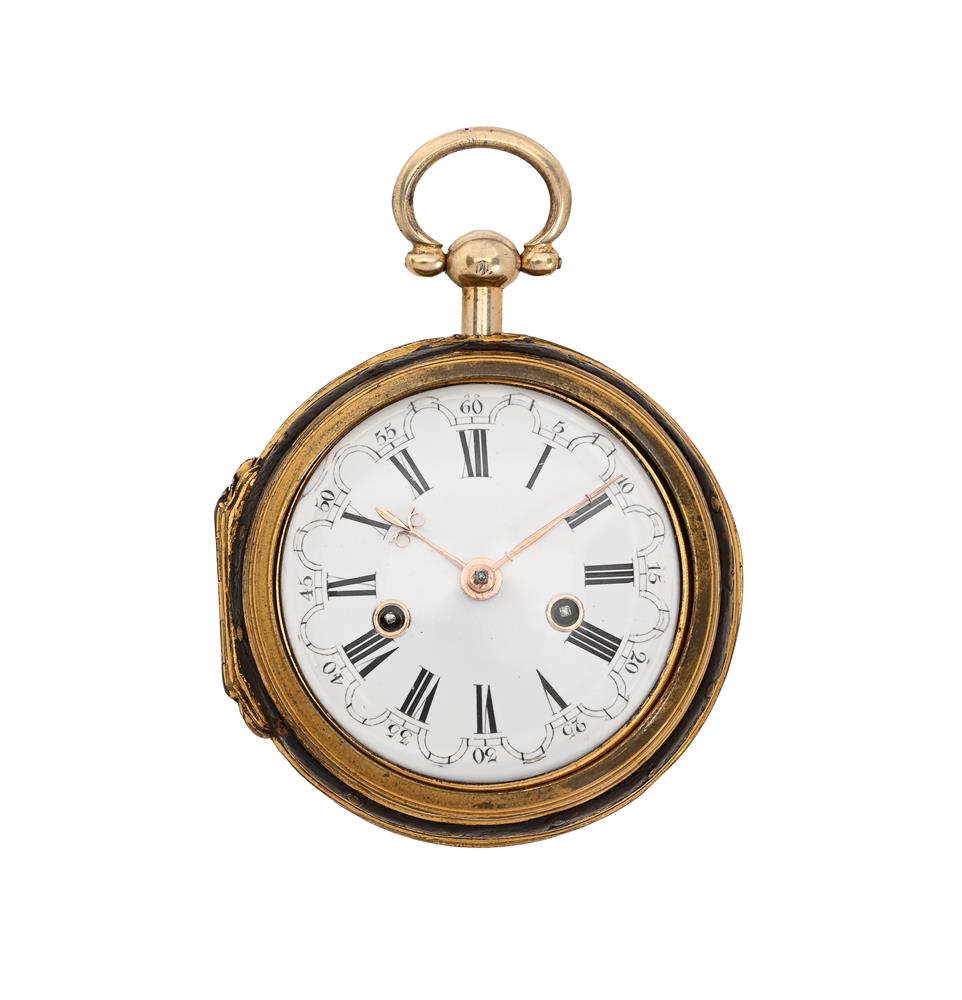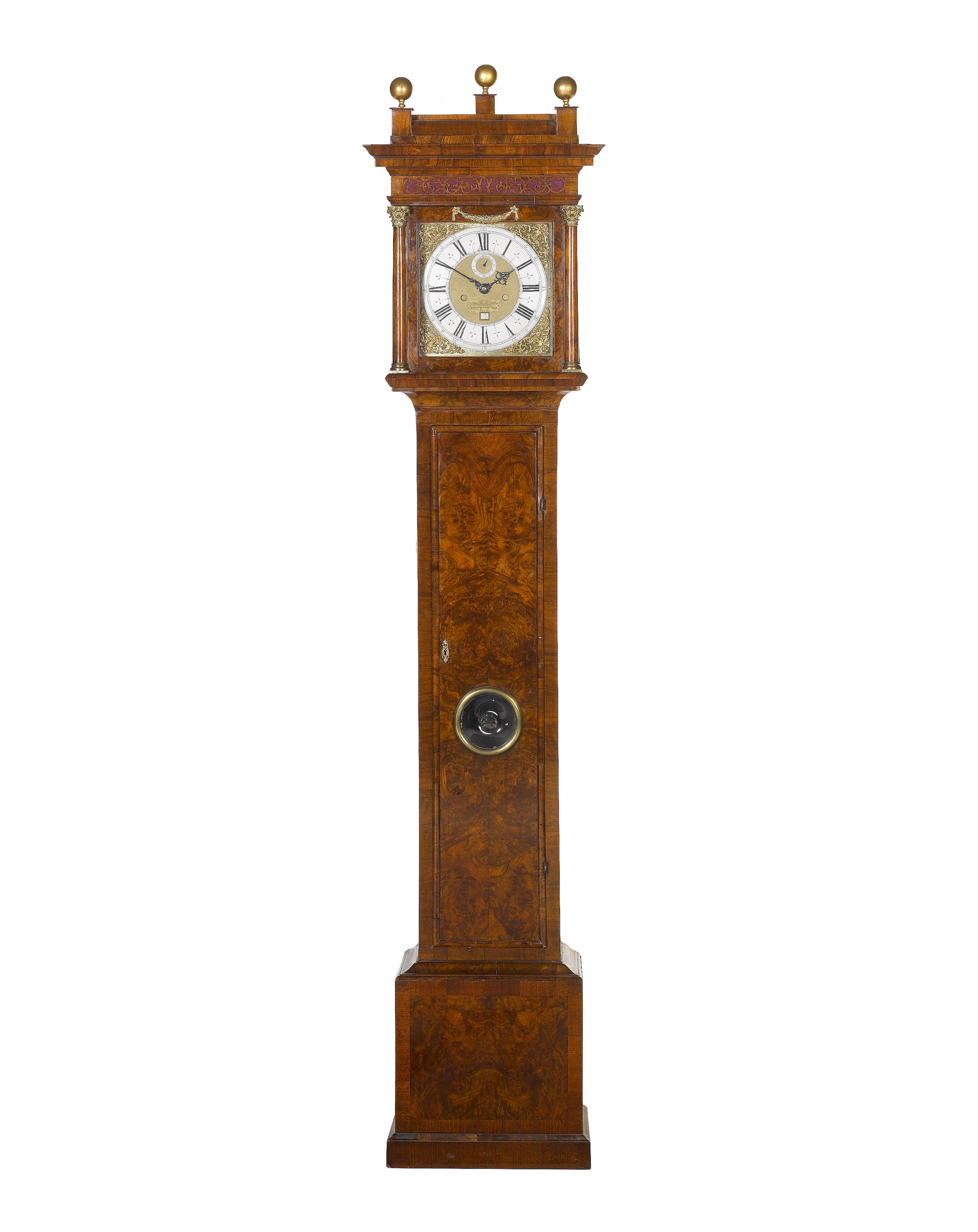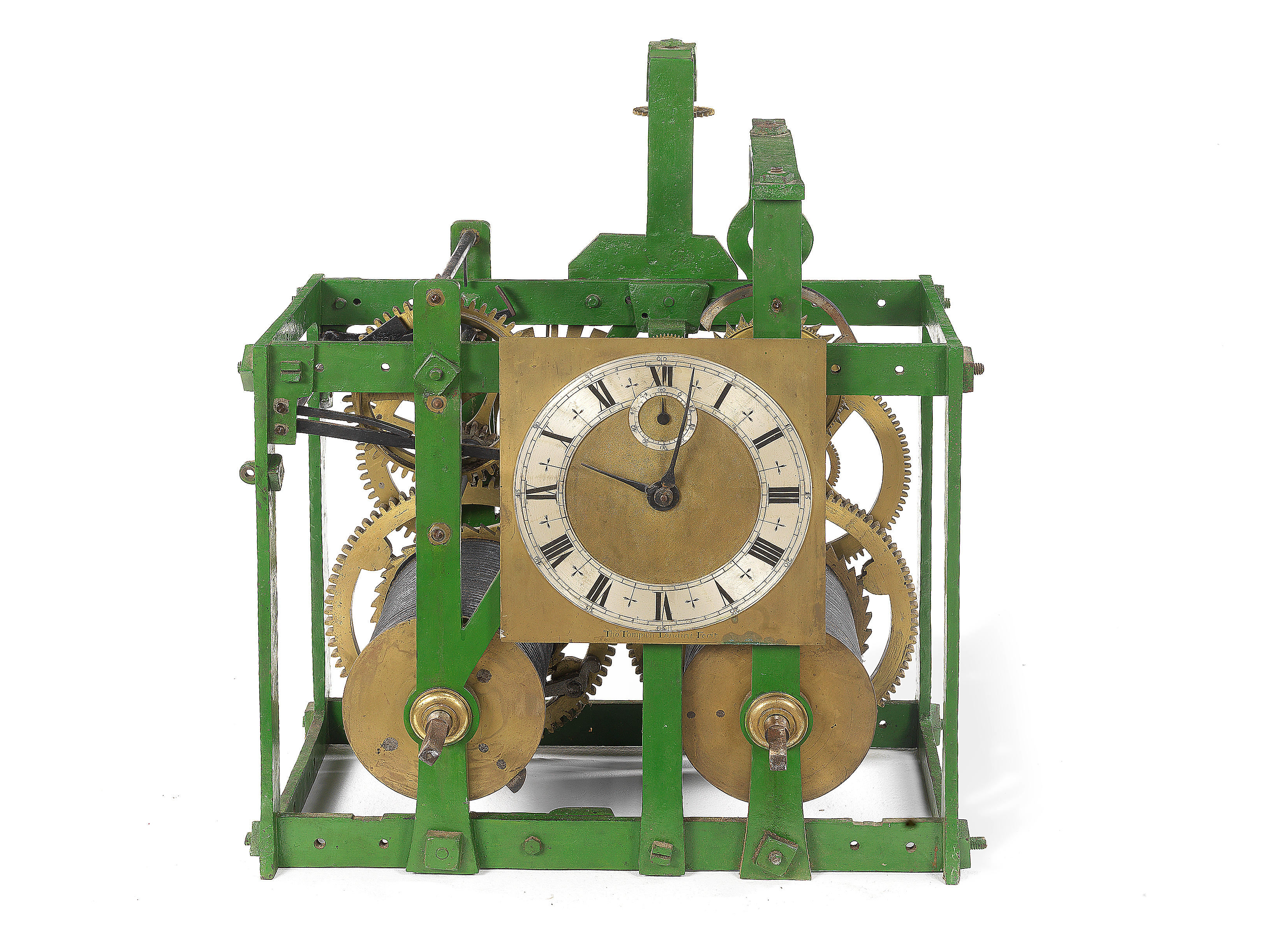Thomas Tompion London, an important William and Mary eight-day longcase clock in a 'mulberry' veneered case number 253, circa 1695 The fully-latched five knopped and finned pillar inside countwheel bell-striking movement with anchor escapement, bolt-and-shutter maintaining power and long crutch, the backplate cut with an aperture for the anchor pallets and punch-stamped 253 to the centre of the lower edge, the 11 inch square brass dial with subsidiary seconds dial and calendar aperture with pin-hole adjustment to the finely matted centre within an applied silvered Roman numeral chapter ring with cruciform half-hour markers and Arabic five minutes to the narrow outer track, with fine pierced blued-steel hands and angles applied with winged cherub mask and scroll cast spandrels with foliate engraved infill between, maintaining power lever at 2 o'clock and signed Tho: Tompion, Londini fecit to lower edge, in a stained field maple ('mulberry') veneered case with moulded cornice and foliate pierced fret above rectangular side windows and plain integral pilasters to hood, the trunk with convex throat moulding and 42 inch rectangular door with brass edged circular lenticle, each side divided by fine narrow ebony and box triple-line inlay into two panels, the base with conforming border, on a later mounded skirt, case with some restoration, 203cm high. Thomas Tompion has often been referred to as the 'father of English clockmaking'. When considering the legacy of his work and influence on subsequent generations of clockmakers, such a compliment is justly deserved. Born in Ickwell, Suffolk in 1639 Thomas Tompion appears to have developed an affinity for metalworking from his father, also named Thomas, who worked as a blacksmith. By 1670 Tompion had moved to London and had become involved in the clockmaking trade. Although there is no record of his apprenticeship or whether he had received any formal training prior to moving to London, he quickly became established, becoming Free of the Clockmakers Company in 1674. His early clocks demonstrate a close working relationship with the Fromanteel, East and Knibb workshops. Around this time Tompion became friendly with the eminent mathematicians and scientists Jonas Moore and Robert Hooke perhaps the most progressive and inventive minds of the day. Such associations led to Royal commissions, firstly from Charles II for whom Tompion is known to have made one of the earliest balance-spring watches in 1676, and later William III who ordered numerous clocks to furnish his various palaces throughout his reign. As well as being an extremely talented artisan Tompion was also commercially minded, cleverly introducing serial numbering for his clocks in around 1682. This, as well as maintaining a high degree of refinement in both the construction and design of his clocks, ensured the highest level of exclusivity for clients purchasing examples from his workshop. By the 1690s his reputation was such that Tompion was receiving orders from all levels of European nobility. In around 1700 Tompion took a former apprentice, Edward Banger, into partnership however this arrangement came to an abrupt end in 1707-8 for reasons unknown. In 1711 a second partnership with George Graham was established who, in turn, inherited the business when Tompion died in 1713. Graham continued the business to the same exacting standards as his former master until his death in 1751. The current lot is numbered 253 which, according to Jeremy Evans (THOMAS TOMPION at the Dial and Three Crowns page 71), would date the movement and dial to around 1695. The movement, although of relatively standard specification, is very finely finished with details such as the fine wheelwork and exquisitely worked tail to the steel hammer spring being a delight to behold. The dial is a good example of Tompion's refined layout, with engraving almost certainly by 'G195'. The case exhibits details in design and construction commensurate with other exa
Thomas Tompion London, an important William and Mary eight-day longcase clock in a 'mulberry' veneered case number 253, circa 1695 The fully-latched five knopped and finned pillar inside countwheel bell-striking movement with anchor escapement, bolt-and-shutter maintaining power and long crutch, the backplate cut with an aperture for the anchor pallets and punch-stamped 253 to the centre of the lower edge, the 11 inch square brass dial with subsidiary seconds dial and calendar aperture with pin-hole adjustment to the finely matted centre within an applied silvered Roman numeral chapter ring with cruciform half-hour markers and Arabic five minutes to the narrow outer track, with fine pierced blued-steel hands and angles applied with winged cherub mask and scroll cast spandrels with foliate engraved infill between, maintaining power lever at 2 o'clock and signed Tho: Tompion, Londini fecit to lower edge, in a stained field maple ('mulberry') veneered case with moulded cornice and foliate pierced fret above rectangular side windows and plain integral pilasters to hood, the trunk with convex throat moulding and 42 inch rectangular door with brass edged circular lenticle, each side divided by fine narrow ebony and box triple-line inlay into two panels, the base with conforming border, on a later mounded skirt, case with some restoration, 203cm high. Thomas Tompion has often been referred to as the 'father of English clockmaking'. When considering the legacy of his work and influence on subsequent generations of clockmakers, such a compliment is justly deserved. Born in Ickwell, Suffolk in 1639 Thomas Tompion appears to have developed an affinity for metalworking from his father, also named Thomas, who worked as a blacksmith. By 1670 Tompion had moved to London and had become involved in the clockmaking trade. Although there is no record of his apprenticeship or whether he had received any formal training prior to moving to London, he quickly became established, becoming Free of the Clockmakers Company in 1674. His early clocks demonstrate a close working relationship with the Fromanteel, East and Knibb workshops. Around this time Tompion became friendly with the eminent mathematicians and scientists Jonas Moore and Robert Hooke perhaps the most progressive and inventive minds of the day. Such associations led to Royal commissions, firstly from Charles II for whom Tompion is known to have made one of the earliest balance-spring watches in 1676, and later William III who ordered numerous clocks to furnish his various palaces throughout his reign. As well as being an extremely talented artisan Tompion was also commercially minded, cleverly introducing serial numbering for his clocks in around 1682. This, as well as maintaining a high degree of refinement in both the construction and design of his clocks, ensured the highest level of exclusivity for clients purchasing examples from his workshop. By the 1690s his reputation was such that Tompion was receiving orders from all levels of European nobility. In around 1700 Tompion took a former apprentice, Edward Banger, into partnership however this arrangement came to an abrupt end in 1707-8 for reasons unknown. In 1711 a second partnership with George Graham was established who, in turn, inherited the business when Tompion died in 1713. Graham continued the business to the same exacting standards as his former master until his death in 1751. The current lot is numbered 253 which, according to Jeremy Evans (THOMAS TOMPION at the Dial and Three Crowns page 71), would date the movement and dial to around 1695. The movement, although of relatively standard specification, is very finely finished with details such as the fine wheelwork and exquisitely worked tail to the steel hammer spring being a delight to behold. The dial is a good example of Tompion's refined layout, with engraving almost certainly by 'G195'. The case exhibits details in design and construction commensurate with other exa















Testen Sie LotSearch und seine Premium-Features 7 Tage - ohne Kosten!
Lassen Sie sich automatisch über neue Objekte in kommenden Auktionen benachrichtigen.
Suchauftrag anlegen